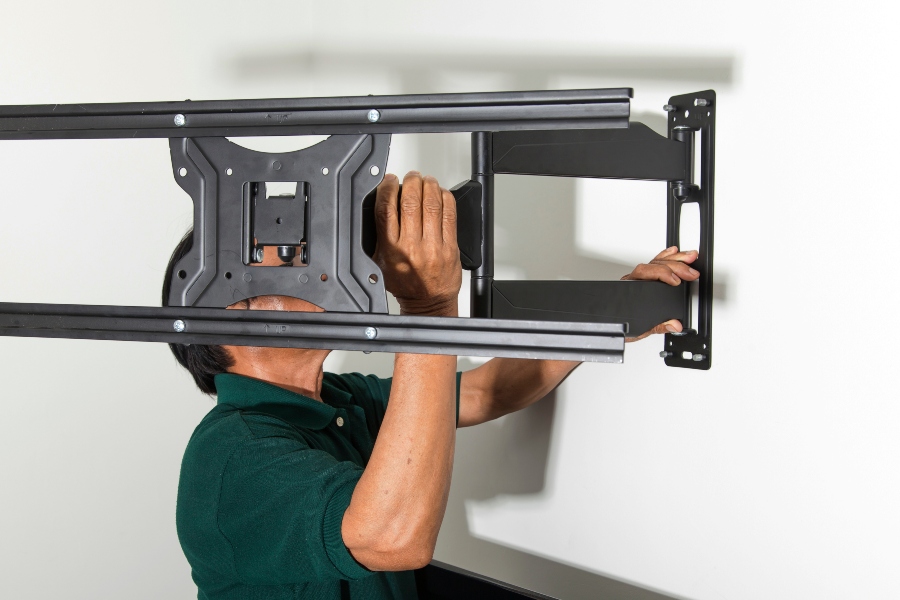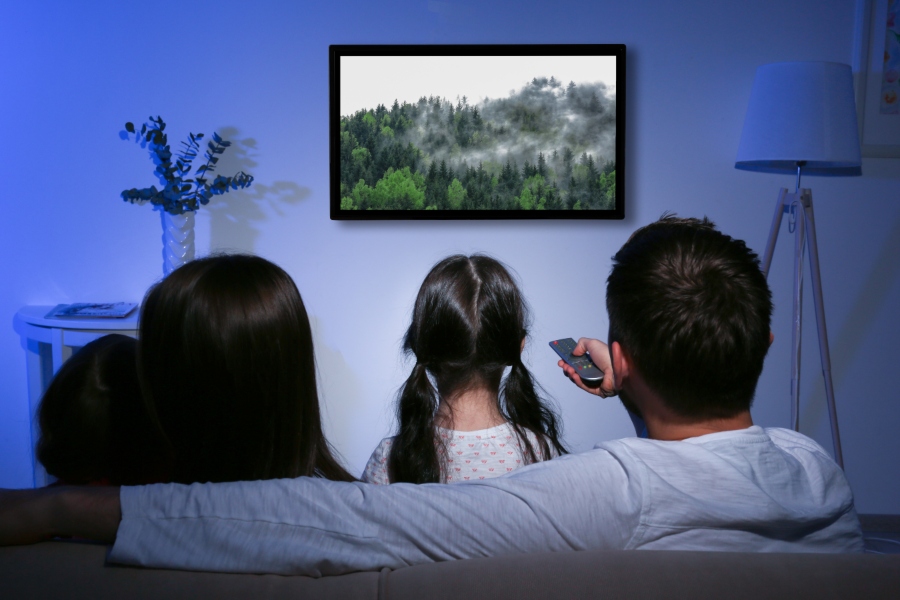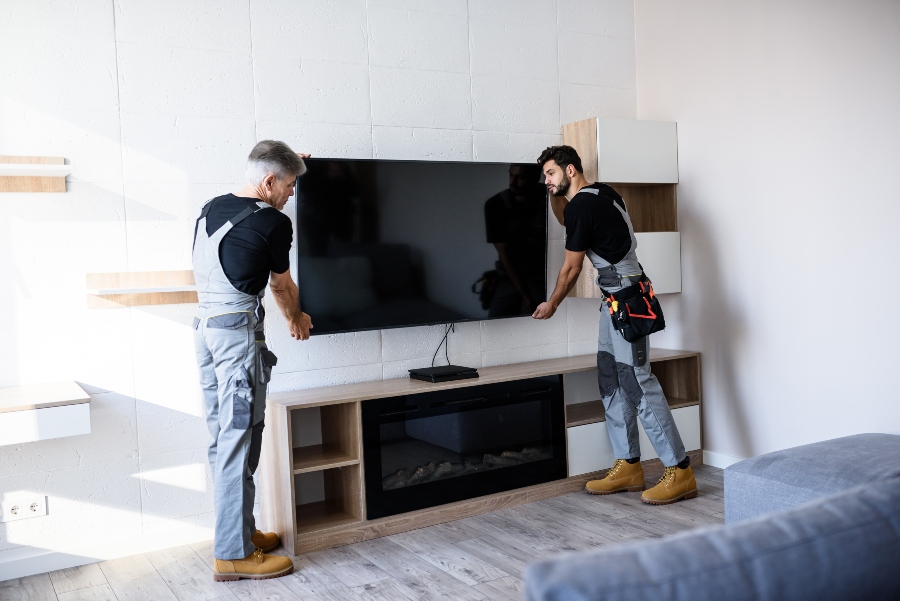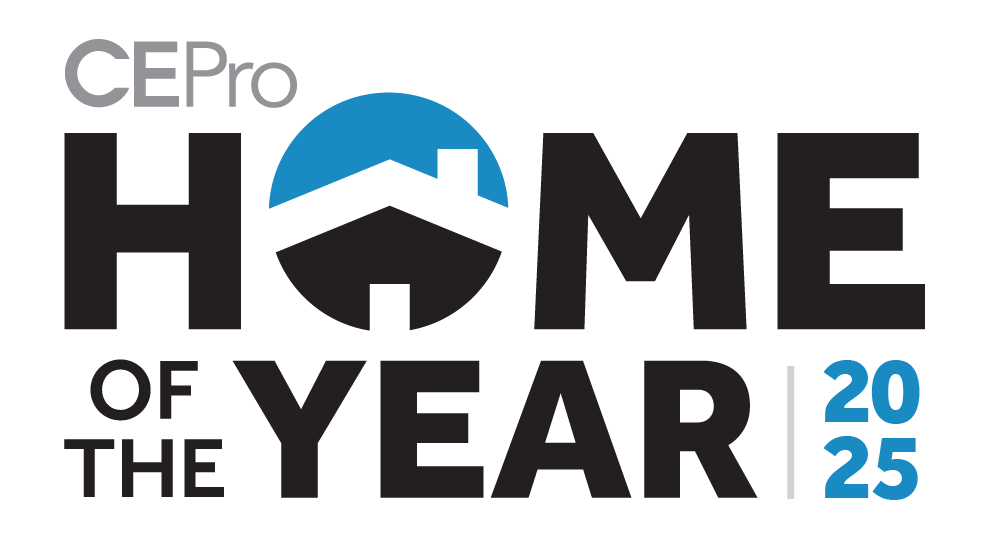The ideal height to mount a TV on the wall is one that provides a comfortable viewing experience while preserving video integrity at a distance. Generally, this means a TV should be mounted high enough on a wall that the audience, when seated, will have the center at eye level.
Another way to look at it is that the TV should be around 42-inches off the ground when measuring from the center of the screen to the floor. However, this is not always the case, and a variety of factors can influence how high a TV should be mounted on the wall.
These factors include:
- Seating Height
- Viewing Distance
- Room Layout
- TV Mount Type
- And Personal Preference
In this article, we’ll go over how these factors TV mounting height, and other methods for calculating proper TV heights outside of the general recommended guidelines with the help of experts from MantelMount.
How High to Mount a TV

Naypong Studio – stock.adobe.com
According to the experts at MantelMount, the ideal mounting height for a TV should be around 42-inches measured from the ground to the center of the screen.
This is a rule of thumb that works with just about any screen up to 85-inches in diagonal length, assuming all members of the audience will be seated at about average height.
For a more tailored experience, however, the experts at MantelMount have a specialized set of recommended TV mounting heights based on their project experience.
These vary from the general recommendation and allow for greater floor clearance while still maintaining optimal comfort. Let’s look at various TV sizes and their recommended mounting height:
- A 43-inch TV should be 56 inches from floor to TV center.
- A 55-inch TV, meanwhile should be mounted 61-inches high off the ground.
- A 65-inch TV, should be mounted 65 inches from floor to TV center.
- And a 70-inch TV should be mounted 67 inches from floor to TV center.
Of course, the height of the TV should be adjusted based on specific factors such as how far away the audience is seated from the TV or what the layout of the room is like.
Additional Considerations When Determining TV Height
Seating Height

BCFC – stock.adobe.com
The above metric assumes that all seating will be at the same height in the room, however, in the case of media rooms or multipurpose rooms, this may not be the case.
Traditional sofas mixed with bar stools or even bean bags will place audience viewing height at odds with one another, requiring alternative approaches to calculating the ideal viewing height of the TV.
Consider these methods:
- Calculate the average viewing height across the different seating types and use this as a measurement of how high you should mount the TV.
- Use the height of the most predominant type of seating as your baseline.
Viewing Distance

Africa Studio -stock.adobe.com
Proximity is essential to viewer immersion, however, the closer the audience is to the TV, the more strain will be put on the eyes, and the more differences in height will be felt in the neck. Ever have the displeasure of sitting front row at a commercial cinema?
In general, the bigger the TV, the further away you’re going to want your audience to sit. Let’s use a 65-inch TV as an example for calculating what is a healthy and immersive viewing distance:
- To calculate the ideal viewing distance for your TV, all you need to do is divide its diagonal length by 0.55, meaning the ideal viewing distance is 118 inches (roughly nine feet) away.
- For a 55-inch display, that translates to 100 inches, or a little over eight feet of viewing distance.
- For 42-inches, a 76-inch viewing distance is recommended.
- No matter what, just divide the display size by 0.55 and you’ll have your ideal viewing distance.
Room Layout

Svitlana – stock.adobe.com
Depending on the room, different pieces of furniture and design elements can severely limit where the TV can be mounted. Consider these elements:
- Fireplace mantels generally dictate a TV be mounted far higher than the general recommendation to avoid damage from heat and soot. In this scenario, having something like a drop-down TV mount can help combat the high viewing angle.
- Some TVs might require cabinets or dressers underneath them to store other devices such as speakers or media players. In this case, it’s generally recommended the TV be given 4 to 6 inches of clearance between the furniture and the TV bottom.
- If you’re not planning on running wire through the wall, you’ll want to be aware of your nearest wall outlet or power source to keep wire visibility to a minimum.
- Avoid locations where the TV will be in direct sunlight, as this can result in a frustrating glare while also damaging the TV’s image quality over time.
Viewing Angle

Naypong Studio – stock.adobe.com
Running parallel to TV height in terms of importance is viewing angle.
In this regard, the general rule of thumb states that a TV should have no more than a 15-degree vertical angling with respect to viewers. For horizontal viewing, there should be no more than a 40-degree angling.
This is because viewing TV at off angles can not only strain eyes and necks, but it can also impact picture quality.
Mounts

Alex – stock.adobe.com
A mount can help alleviate and/or solve many of the issues listed above by giving greater freedom of viewing angle, height and distance. We offer a more in-depth look in our TV mount buying guide, but for now, consider these options:
- A TV mount that can tilt and/or swivel can be adjusted so that when seated a viewer will be looking directly at the TV even if its slightly higher than normal viewing height.
- A drop-down TV mount can make so TVs placed above fireplace mantels or other pieces of furniture drop down to eye level when needed.
Closing Thoughts
Regardless of whether you are a professional or an amateur, mounting a TV to a wall can be a high stakes task. Knowing how high to mount a TV depends on quite a few factors that need to be known ahead of time. However, when in doubt, always strive to keep the center of the TV at eye level with the rest of the audience, either through initial placement, or through clever use of TV mounts.







